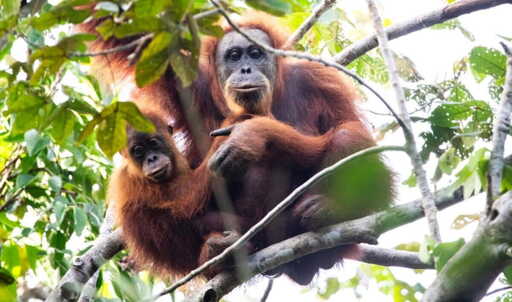CENTRAL TAPANULI, Indonesia — Since it was first described by scientists in 2017, the Tapanuli orangutan, one of the world’s rarest great apes, was believed to live only in the Batang Toru forest of Indonesia’s North Sumatra province. But new findings reveal that the species (Pongo tapanuliensis) also inhabits a peat swamp forest some 32 kilometers (20 miles) away, adding a new layer to the understanding of its range. On Sept. 26, 2025, a field team from the Sumatran Orangutan Conservation Foundation–Orangutan Information Centre (YOSL-OIC), accompanied by Mongabay Indonesia journalist Junaidi Hanafiah, documented a mother and infant orangutan in the secondary forest of Lumut Maju village in Central Tapanuli district. The observation followed hours of trekking through thick vegetation, and the sighting became the first confirmed record of Tapanuli orangutans in this area, which borders the Indian Ocean. The location first drew attention in 2022, when local residents reported orangutan sightings to YOSL-OIC’s Human-Orangutan Conflict Response Unit (HOCRU). Initial verification found no apes, but did reveal five nests. Later that year, HOCRU and the YOSL-OIC research team returned for further monitoring across the 1,234-hectare (3,049-acre) peat swamp. They found 17 nests, several newly constructed, indicating active use of the forest by orangutans. “We found new nests that we categorized as class one nests, which we can confirm to have orangutans,” Rio Ardi, the research manager at YOSL-OIC, told Mongabay. A previously unknown home of Tapanuli orangutans has been discovered in a peat swamp forest in North Sumatra. Image by Junaidi…This article was originally published on Mongabay
From Conservation news via this RSS feed


